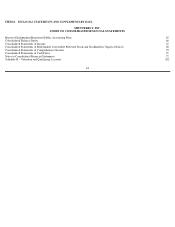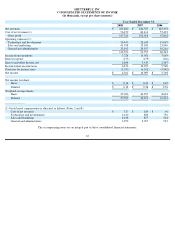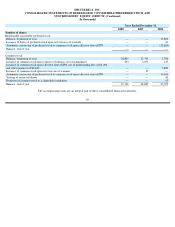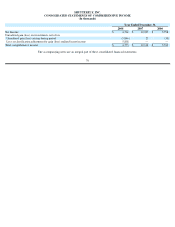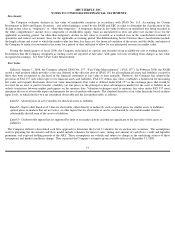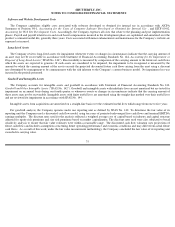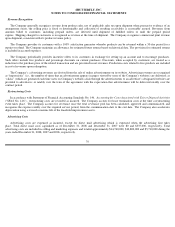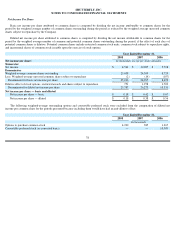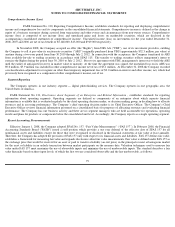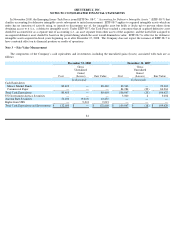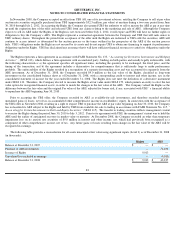Shutterfly 2009 Annual Report Download - page 76
Download and view the complete annual report
Please find page 76 of the 2009 Shutterfly annual report below. You can navigate through the pages in the report by either clicking on the pages listed below, or by using the keyword search tool below to find specific information within the annual report.
SHUTTERFLY, INC.
NOTES TO CONSOLIDATED FINANCIAL STATEMENTS
On January 1, 2008, the Company adopted SFAS No. 159, “The Fair Value Option for Financial Assets and Financial Liabilities-
Including
an amendment of FASB Statement No. 115.”
SFAS No. 159 permits companies to choose to measure certain financial assets and liabilities at
fair value (the “fair value option”).
If the fair value option is elected, any upfront costs and fees related to the item must be recognized in
earnings and cannot be deferred, e.g. debt issue costs. The fair value election is irrevocable and may generally be made on an instrument-by-
instrument basis, even if a company has similar instruments that it elects not to fair value. At the adoption date, unrealized gains and losses on
existing items for which fair value has been elected are reported as a cumulative adjustment to beginning retained earnings. The Company chose
not to elect the fair value option for its financial assets and liabilities existing on January 1, 2008, and did not elect the fair value option for any
financial assets and liabilities transacted during the twelve months ended December 31, 2008, except for the Rights related to the Company’
s
auction rate securities that was recorded in conjunction with signing an agreement with one of the Company's investment advisors. See Note 3-
Fair Value Measurement.
Concentration of Credit Risk
Financial instruments that potentially subject the Company to credit risk consist principally of cash, cash equivalents, short term
investments, and accounts receivable. As of December 31, 2008, the Company's cash and cash equivalents were maintained by financial
institutions in the United States and its deposits may be in excess of insured limits. The Company believes that the financial institutions that hold
its investments are financially sound and, accordingly, minimal credit risk exists with respect to these investments.
The Company’
s accounts receivable are derived primarily from sales to customers located in the United States who make payments
through credit cards, sales of the Company's products in retail stores, and revenue generated from online advertisements posted on the
Company's website. Credit card receivables settle relatively quickly and the Company maintains allowances for potential credit losses based on
historical experience. To date, such losses have not been material and have been within management’
s expectations. Excluding amounts due
from credit cards, as of December 31, 2008, two customers accounted for 38% and 13% of the Company’
s net accounts receivable. And as of
December 31, 2007, two customers accounted for 43% and 11% of the Company’s net accounts receivable.
Inventories
Inventories are stated at the lower of cost on a first-in, first-
out basis or net realizable value. The value of inventories is reduced by
estimates for excess and obsolete inventories. The estimate for excess and obsolete inventories is based upon management’
s review of utilization
of inventories in light of projected sales, current market conditions and market trends. Inventories are primarily raw materials and consist
principally of paper, photo book covers and packaging supplies.
Property and Equipment
Property and equipment, including equipment under capital leases, are stated at historical cost, less accumulated depreciation and
amortization. Depreciation and amortization are computed using the straight-
line method over the estimated lives of the assets, generally three to
five years. Amortization of equipment acquired under capital lease obligations is computed using the straight-
line method over the shorter of the
remaining lease term or the estimated useful life of the related assets, generally three to four years. Leasehold improvements are amortized over
their estimated useful lives, or the lease term if shorter, generally three to seven years. Upon retirement or sale, the cost and related accumulated
depreciation are removed from the balance sheet and the resulting gain or loss is reflected in operating expenses. Major additions and
improvements are capitalized, while replacements, maintenance and repairs that do not extend the life of the asset are charged to expense as
incurred.
74


